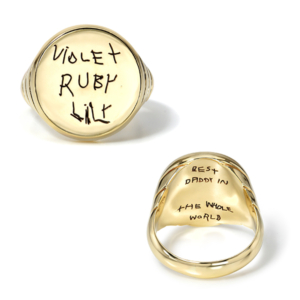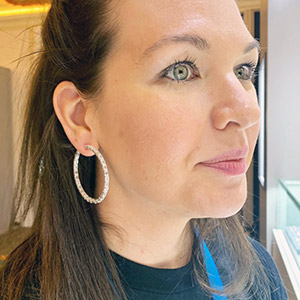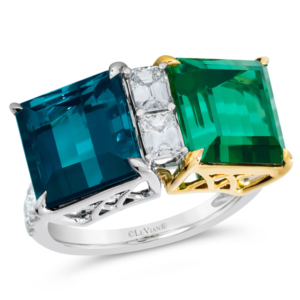
JCK editor-in-chief Victoria Gomelsky and news director Rob Bates speak with Israel-based diamond industry analyst Edahn Golan, owner and manager of Edahn Golan Diamond Research & Data and managing partner of Tenoris, which supplies retail and consumer trend data and analytics to the fine jewelry and gemstone industries. Golan explains how he began his career and got hooked on diamond data, a subject he still finds fascinating, and offers insights into the future of lab-grown and natural diamonds. Bonus: what to expect for holiday sales this year.
Listen Now
Sponsored by De Beers: institute.debeers.com
Show Notes
01:55 Introductions and a brief report from Israel
04:20 A passion for data analytics
08:24 Lab-grown engagement rings trending
12:44 Forecast for the lab-grown market
18:57 Rethinking the lab-grown story
22:06 Holiday sales predictions
Episode Credits
Hosts: Rob Bates and Victoria Gomelsky
Producer and engineer: Natalie Chomet
Editor: Riley McCaskill
Plugs: @jckmagazine; institute.debeers.com, tenoris.bi
Show Recap
Introductions and a brief report from Israel
Victoria introduces guest Edahn Golan, a longtime diamond industry analyst based in Netanya, a city about 20 miles north of Tel Aviv. Though he is not close to the war-torn parts of Israel, the mood is still tense, and recent events are “difficult to digest psychologically,” Edahn says. “The streets are kind of deserted, so there’s an eerie feeling in the air.”
A passion for data analytics
Victoria notes that Edahn’s American accent is nearly flawless and asks about his background. “I’m a native Californian,” he says. Born to Israeli parents studying in Los Angeles, he spent his first six years in the United States, then moved to Israel. In his early 20s, Edahn returned to the U.S. for college and began his career in the Golden State in broadcasting. Initially, he dreamed of making documentaries for National Geographic. But soon he found himself drawn to economics and technology—he had a natural talent for both, successfully dismantling and reassembling his own computer.
A friend worked at the company that would become IDEX Online and encouraged him to apply. Though Golan knew nothing about jewelry, he joined the diamond trading platform just before it launched in 2001 and built its news section.
He quickly found himself focusing on price analysis, a specialty that intensified after the 2008 financial crisis, when companies needed insights on potential opportunities. “I found it fascinating to do that kind of in-depth analysis,” he says. “I was sitting on a treasure trove of data. If you understand the industry, you can look at this data and put it in context and create something new. It was marvelous.”
After 12 years he left IDEX to form his own research company, providing practical, actionable data for the industry. “Knowing the price of a diamond is going up or down is meaningless unless you put it in context. You’ve got to explain why. Does it impact my business? How does it impact my business?”
Lab-grown engagement rings trending
Rob praises Edahn’s free Tenoris newsletter, which sparked debate recently by reporting that half of all loose stones sold for engagement rings in U.S. are now lab-grown.
“Specialty retailers in the U.S. don’t only buy finished jewelry, they also buy components. One of those components is loose gems, primarily diamonds,” Edahn says. “Because of that, we can track the loose diamond activity and the performance at stores…. We found out that if you look at the loose sales at jewelry retailers in the U.S. today, 50% of their loose sales are lab-grown by units. What do they use loose diamonds for? Primarily engagement rings. Following that is stud earrings.”
What’s sparking the trend? Consumers often pick out a design for an engagement ring rather than a specific stone; once they select a semi-mount, the rest of their budget goes toward a center stone they can afford, he says. That makes less costly lab-grown diamonds appealing to a number of shoppers.
“The question until now often was, is [lab-grown] cannibalizing or expanding the market?” Edahn asks. “The answer is yes, it’s doing both things.”
Forecast for the lab-grown market
Rob notes a growing desire among jewelers to return to natural diamonds. Edahn says he heard the same viewpoint expressed at JCK Las Vegas in June.
“Until 2016, when you asked a jeweler if they would add lab-grown to their offerings, the answer was no, and the reasoning was simple: ‘I am a luxury retailer, and I won’t add synthetics to my offerings,’” Edahn says. “In 2018, that changed. They started to say, ‘I will go where my customer wants me to go.'”
But by 2023, some of these same jewelers have begun to believe the move had hurt their business for two reasons: First, lab-grown sales lower the average transaction value. How do you make up for lost revenue? “The only possible answer is [selling a] lot more, and that’s very difficult to do,” he says. “Very few retailers can double their sales.”
Second, some retailers embraced lab-grown stones as a way to sell against shoppers’ budgets to increase their margins. That approach worked well for some because “it didn’t matter what happened in terms of lab-grown prices. All they did was sell a bigger stone.” However, there’s a larger concern looming: “The perceived value of what they’re offering is decreasing even though their income is the same…. [Retailers are] afraid that somewhere down the line, their loyal customers will walk in and say, ‘My money is gone.’ They won’t be a luxury retailer anymore.”
Edahn’s data says the number of lab-grown units fell in September for the second month in a row. If the product continues to be devalued, and sales start to decline in volume, that’s “a very toxic combination,” he warns.
Rethinking the lab-grown story
What advice does Golan offer the lab-grown community? “You need to understand that you’re creating a component. You’re not in the diamond business. You’re in the lab-grown business.” Retailers should stop saying lab-grown diamonds are the same but different. “It’s not the same because the whole selling proposition of a natural diamond is based on the fact that it’s natural,” Edahn points out. “A diamond is forever. It’s forever because it’s been around for hundreds of millions to billions of years. It’s a symbol of our enduring love. The lab-grown industry can’t say the same.”
Diamond manufacturers need to create their own story, he says. On way would be to promote the product rather than the diamond, he says, citing Swarovski as a model. “Nobody buys Swarovski for their crystals. They buy them for their workmanship, the constant change in designs, and the great designs.”
Holiday sales predictions
Victoria asks Edahn what the industry can expect in terms of holiday sales this year. He says sales should be more in line with 2019 numbers than the highs of 2021 and 2022. The past two years were exceptionally good for the diamond industry because of the pandemic. After dramatic events like COVID-19, or 9/11 or the financial crisis, “people realize they love someone, and they run out and get married,” Edahn explains.
Sales are “going to be a little bit down, but it’s going to improve down the line,” he predicts. And remember, Edahn says, “2019 wasn’t a good year until the last two weeks of December, then sales went through the roof.” He hopes that will happen again.
Any views expressed in this podcast do not reflect the opinion of JCK, its management, or its advertisers.
Follow JCK on Instagram: @jckmagazineFollow JCK on Twitter: @jckmagazine
Follow JCK on Facebook: @jckmagazine






